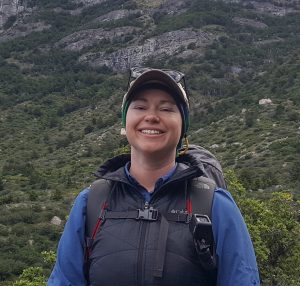Mixing of Metamorphic and Plutonic First-Cycle Detritus in the Pleistocene Bautista Beds

MS Candidate
Advisor: Dr. Gary Girty
Thursday, May 7th, 2020
10:45am – via zoom
watch Bonnie’s defense here
Abstract
During the Pleistocene, the western slopes of the Peninsular Ranges were underlain by the remnants of the erosionally exhumed and deeply dissected Cretaceous magmatic arc rocks of the Peninsular Ranges batholith. As reported in the literature, disconformably overlying these remnants are the Pleistocene Bautista beds which were deposited, for the most part, within a network of low-gradient fluvial channels and adjacent floodplains prior to and during the early development of the San Jacinto fault. In such a setting, sources of detritus in the Bautista beds would have been located west of the drainage divide of the Pleistocene Peninsular Ranges, and would have consisted of high-grade metamorphic rocks, and tonalitic, granodioritic, and monzogranitic plutonic rocks. If detritus is first-cycle, or nearly so, do the modal and geochemical compositions of sandstones in the Bautista beds reflect derivation from varied single source areas or are they mixtures derived from two or more of the above sources? Using published modal compositions from plausible source rocks, along with new point-count data derived from 24 Bautista sandstones, we show that QPK compositions mostly spread from the compositional fields defined by unweathered tonalite and granodiorite toward and into the compositional field defined by unweathered metamorphic rocks of the Burnt Valley complex. Such data imply that feldspathic sandstones of the Bautista beds are primarily mixtures of unweathered tonalite, granodiorite, and metamorphic rock. To further assess this possibility, the A-CN-K compositions of the 24 Bautista sandstones were compared to 28 A-CN-K compositions derived from unweathered tonalites and granodiorites, and from 10 unweathered samples from the Burnt Valley complex. Resulting data again spread from the two compositional fields defined by the latter two components. To evaluate the effects of weathering, compositional linear weathering trends were calculated for various mixtures of unweathered plutonic and metamorphic rock. Data derived from the Bautista beds revealed no to modest effects of weathering. Estimates of plausible source to sink distances vary from ~5 km to ~10 km. Such data imply that during transportation from source to sink significant chemical weathering did not take place over these distances. As a result of such short transport distances, QPK and A-CN-K compositions likely reflect mostly processes operating in source-rock regolith. We conclude that sandstones of the Bautista beds are excellent examples of first-cycle detritus deposited on the flanks of a deeply dissected ancient magmatic arc.

